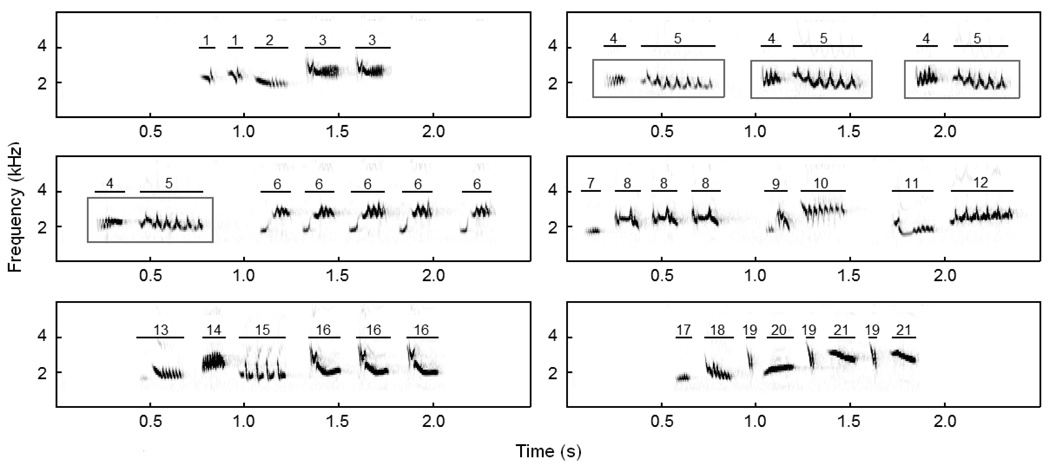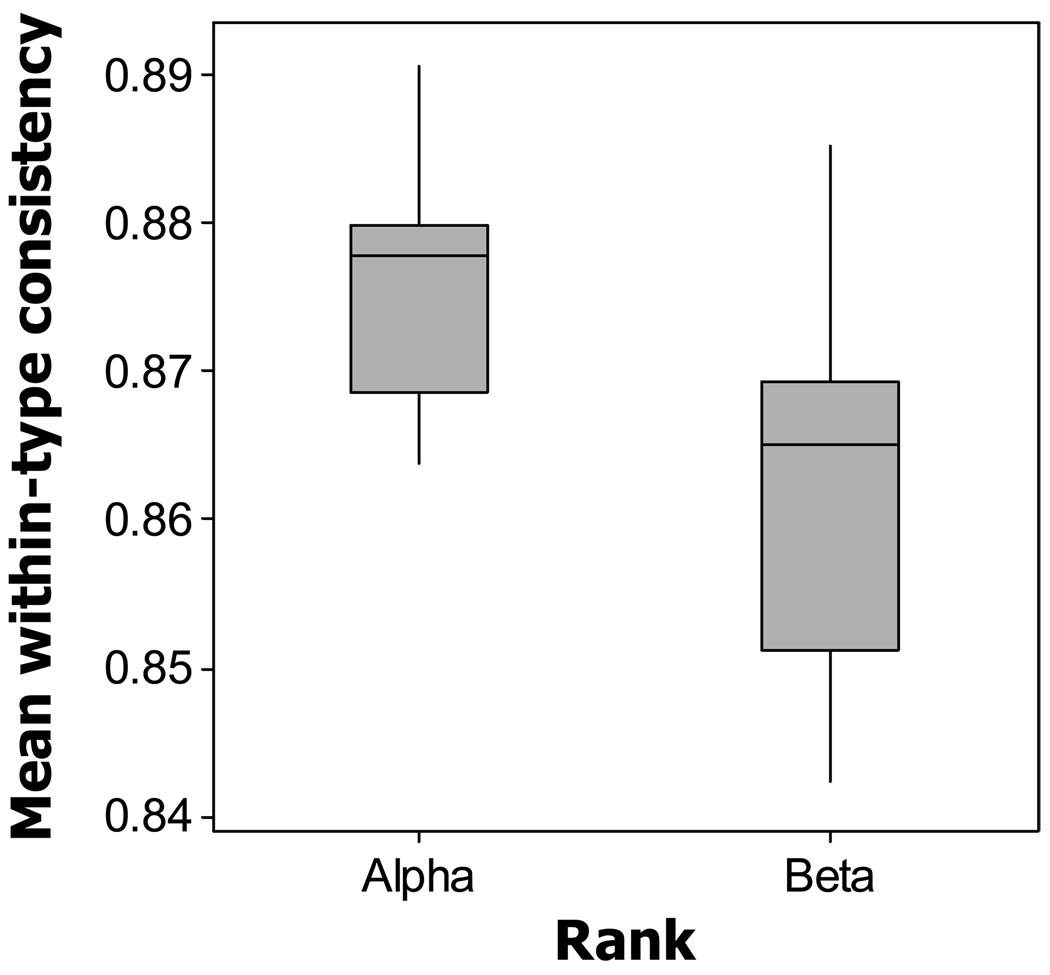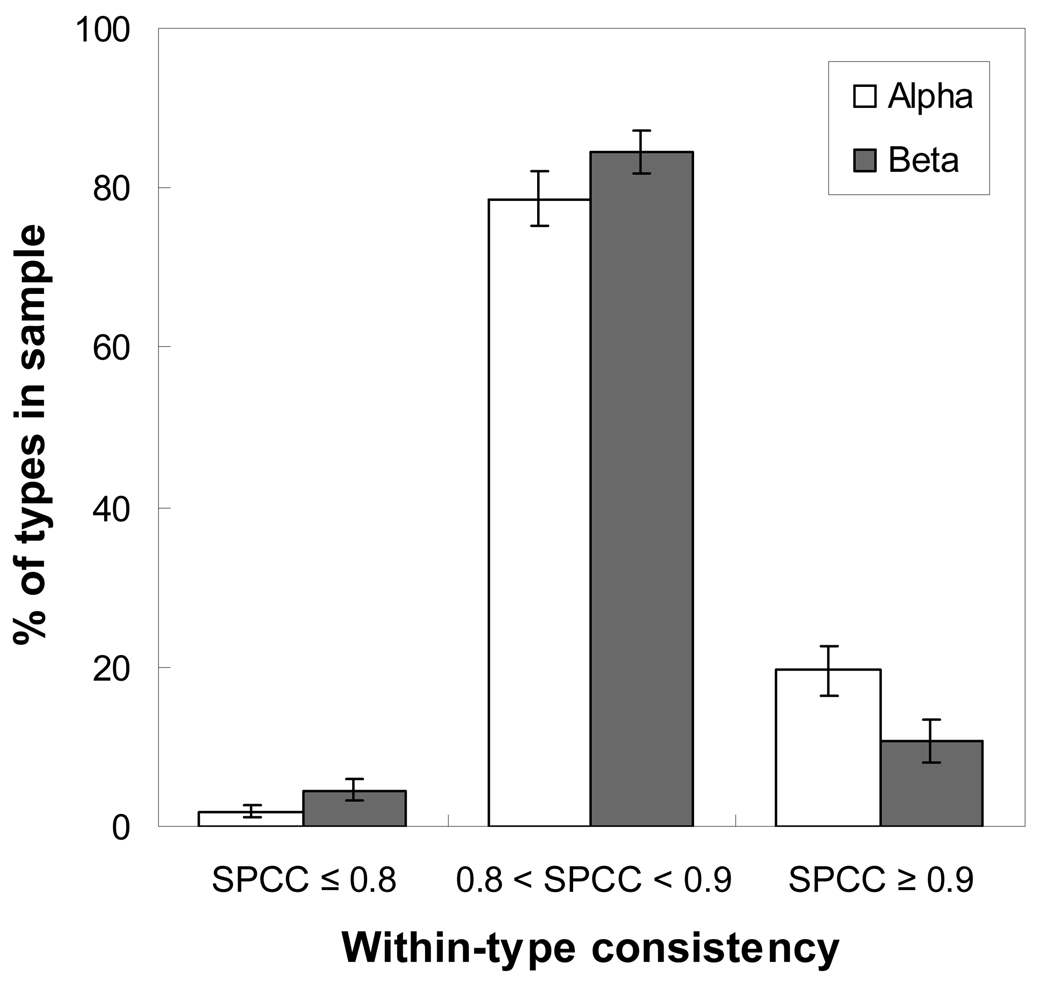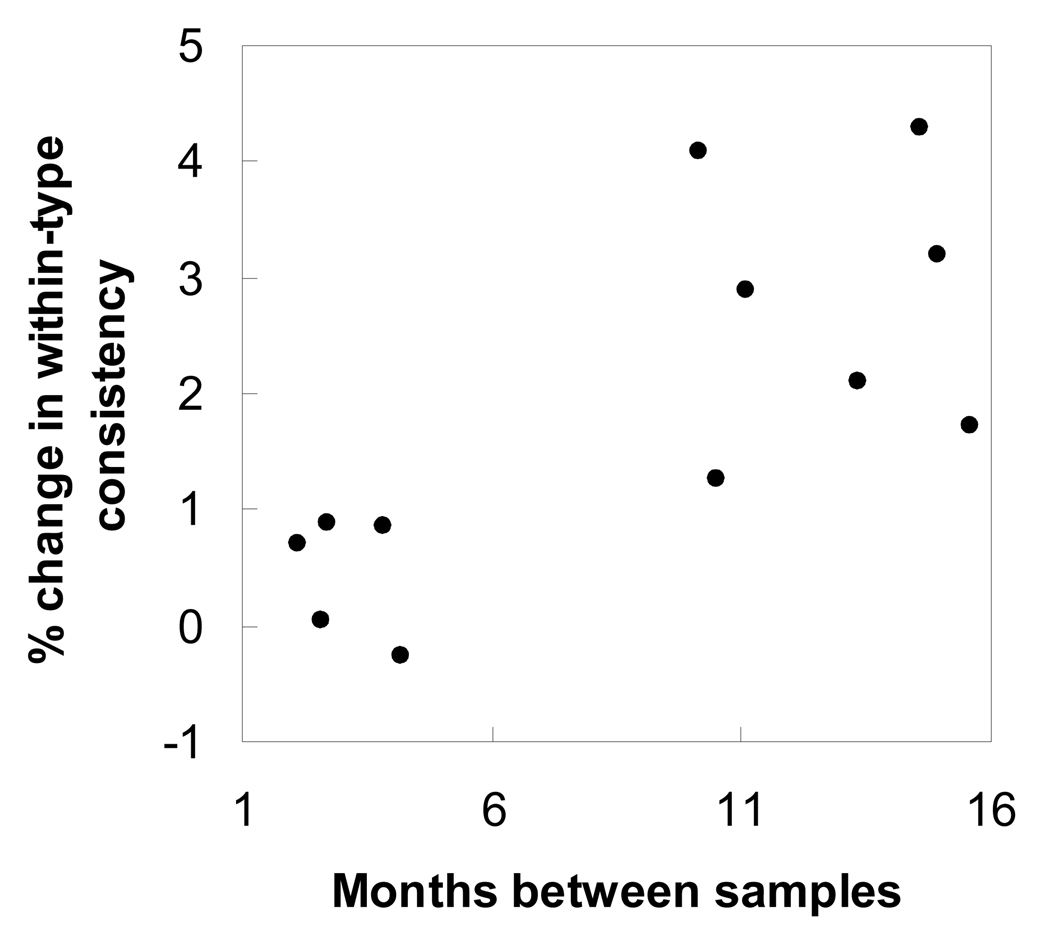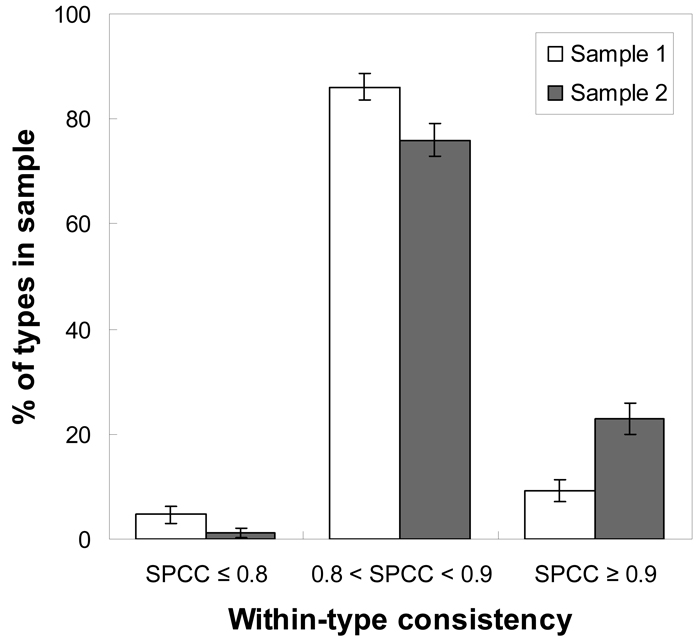Abstract
Many animals repeat standardized displays multiple times while attracting a mate or deterring a rival. In such contexts it is possible that the ability to perform each display or signal type in a consistent fashion is under direct selection. Studies on sexual selection on song learning in birds have focused on differences in repertoire size with less attention to the potential importance of being able to perform each song/syllable type with high consistency. We present evidence that tropical mockingbirds decrease the variation between renditions of each syllable type as they grow older (i.e., become more consistent) and that more consistent males in this species tend to have higher dominance status and reproductive success. These findings stress the importance of consistency in the performance of sexual displays and suggest that this parameter may be very relevant even in species that are selected for high vocal diversity (i.e., large repertoires). In addition to signalling dominance status and age, we hypothesize that syllable type consistency may also be an indicator of the integrity of brain function in birds analogous to the tests used for neuropsychological assessment in humans.
Keywords: Mimus gilvus, performance variability, song crystallization, song learning, tropical mockingbird
Songbirds are among the few taxa that must learn their species-specific signals of communication from other individuals (Kroodsma 1988). Learning how to sing involves the development of appropriate neuromuscular structures, exposure to relevant social stimuli, and practice (reviewed in Beecher and Brenowitz 2005). Early stages of vocal learning include the production of soft, rambling sounds known as ‘subsong’, followed by more stereotypical vocalizations known as ‘plastic songs’ (Hultsch and Todt 2004). In most known bird species, song elements eventually ‘crystallize’ into standard types that are repeated thereafter with remarkably low variability (Tumer and Brainard 2007). Crystallized types are observed in both age-restricted and open-ended learning species (Read and Weary 1992).
Previous studies on the potential information content and selective advantages of song learning have focused on differences in repertoire size (reviewed in Gil and Gahr 2002) and have overlooked the importance of being able to sing each learned type in a consistent fashion (but see Byers 2007). This bias stems from the tacit assumption that the most important aspects of learning occur prior to crystallization. However, recent evidence suggests that learning continues after song crystallization. For example, adult birds can adaptively adjust their motor patterns to optimize performance and minimize variability among renditions of each type when exposed to disruptive stimuli (Tumer and Brainard 2007). Thus, we hypothesized that the amount of variability in syllable type performance could be a signal of individual quality, with higher quality individuals showing less variability (i.e., being more consistent). A similar relationship between performance variability and individual quality has been suggested for motor displays in other modalities (Jordao et al. 2007; Zahavi 1980).
We tested our hypothesis in the tropical mockingbird, Mimus gilvus, investigating whether within-type consistency is related to age, social dominance, and reproductive success. Tropical mockingbirds live in cooperative breeding groups with multiple members of each sex that cooperate in the defence of a territory (Botero et al. 2007; Morton et al. 2004). Same-sex group members are organized in linear dominance hierarchies. In some groups, the two highest-ranking males (i.e., the alpha and beta males) compete with each other for mating with the highest ranking female (Botero et al. 2007). Both alpha and beta males build nests and sing conspicuously prior to a breeding attempt, but alpha males tend to displace betas rather than be displaced by them, to perch higher when in the same tree, and to have higher song output (Botero et al. 2007). Tropical mockingbirds are multibrooded and their peaks in reproductive activity coincide with the rainy seasons (Paredes et al. 2001). Most male song occurs prior to a breeding attempt (Paredes et al. 2001). Each male learns over a hundred different syllable types (Botero et al. 2008) and combines them in multiple ways to produce a much larger number of songs (Fig. 1). Songs are presented with eventual variety and syllable types are conserved from year to year.
Figure 1.
Selected songs of one of our focal male tropical mockingbirds in Villa de Leyva, Colombia. Lines above the spectrogram indicate syllables and numbers are used to identify syllable types. Grey boxes show how syllable types (in this case, types four and five) are combined in different ways to produce a virtually unlimited number of song types. The songs with the grey boxes were recorded in different years, suggesting that at least part of the syllable type repertoire is conserved throughout an individual’s life. The examples shown were chosen to illustrate the vocal diversity of male tropical mockingbirds and do not reflect the actual types included in our analysis.
METHODS
Study population
From August to December 2004 and from August 2005 to May 2006, we monitored 23 social groups of individually colour-banded tropical mockingbirds in Villa de Leyva, Colombia as part of an ongoing study on song learning and song use (Botero et al. 2007). These social groups include 1.8 ± 0.20 males (mean ± SE) and 1.8 ± 0.16 females (data based on 19 groups for which molecular data is available). Adult birds were captured once using nylon mist nets (mesh = 38 mm) and were outfitted with two coloured darvic bands in one leg and one coloured darvic band plus a numbered aluminium band in the other (www.avinet.com). Before releasing each subject, we collected a small genetic sample by extracting approximately 0.05ml of blood from the brachial vein on the left wing. Samples were obtained by gently poking the vein with a sterile insulin needle and collecting a drop of blood with a heparinized capillary tube. Blood samples were stored in Queen’s Lysis Buffer until the time of analysis (see below). Capture, banding and genetic sampling protocols were approved by Cornell University’s Institutional Animal Care and Use Committee and, locally, by the Instituto de Investigación de Recursos Biológicos Alexander von Humboldt.
Cross-sectional analysis
Twenty-three reproductively active males, each from a different focal group, were recorded opportunistically during periods of sustained song output (11 alpha males and 12 beta males). Recordings were made at close proximity with a Marantz PMD690 digital recorder (16 bits per sample, 48000 samples per second) and a Sennheiser ME67 directional microphone. Dominance ranks were determined through direct observation of agonistic interactions and comparison of song output.
Within-type consistency was measured as the average spectral cross-correlation (SPCC) for 20 randomly selected syllable types per individual (n=10 exemplars per type, each exemplar was correlated against every other exemplar of its type). Syllables were defined as a sound, or group of sounds, that was separated from other sounds by more than 0.04 s of silence (see Fig. 1). The only exceptions to this rule were the rare occasions in which the same types of sounds happened to be separated, within a single recording, by less than 0.04 s of silence in at least eight exemplars and by more than this threshold in the remaining ones, or the other way around (e.g., compare syllable type 13 with types 17 and 18 in Fig. 1). In these situations, we considered all repetitions of these sounds as exemplars of one or two syllable types depending on the decision that applied to the majority of cases. Classification of syllables into types was done jointly by RJM and CAB, based on overall similarity in sound, structure and duration. Types were only classified on a male-by-male basis and we made no attempt to determine which types were shared by different focal males or, in the longitudinal analysis described below, by the same male in different years. Exemplars were selected by RJM, without any knowledge of the social status or age of the focal males. Thanks to the low number of syllable types sampled per bird, the low number of exemplars per type, the large structural differences between types (see Fig. 1), and our strict time-based rules to define syllables, there was full concordance between observers in the classification of syllables into types.
SPCC coefficients were computed with Avisoft-SASLab Pro (www.avisoft.com). These coefficients reflect the similarity between two sounds and range from zero, when there is no similarity, to one, when the sounds are identical (Clark et al. 1987; Coleman et al. 2007). The effects of background noise on our results were minimized by computing the SPCC coefficients using only the frequency bands covered by each syllable type. Exemplars for a given syllable type were obtained from multiple songs recorded in a single day and were chosen based on a good signal-to-noise ratio and an absence of masking sounds. Given the repetitive singing style of the tropical mockingbird, all exemplars for a given type were usually collected within a short period. Different syllable types for a given individual were sampled within five days of each other (mean ± SE = 3.41 ± 1.68 days).
We used binary logistic regression to determine whether mean within-type consistency is a good predictor of social dominance status. The regression model corrected for mean syllable duration and mean frequency bandwidth (also measured with Avisoft-SASLab Pro) because these parameters might have an important effect on the outcome of SPCC. SPCC is a technique that compares images and the larger the area of these images, the higher the number of pixels that need to be compared. Sounds that last longer or cover a larger frequency range will produce spectrograms with larger area and, thus, may show lower similarity values.
Within group reproductive success
Eleven focal groups used in the cross-sectional analysis produced young after we sampled the songs of their constituent alpha and/or beta males (mean ± SE = 2.3 ± 0.6 months from acoustic sample to fledging date). We collected genetic samples from the nestlings produced in these reproductive events (N = 23) at day 13 post-hatching using the same method described for the adults. In a few cases we collected blood from the tarsal rather than the brachial vein. Mockingbird nestlings are almost fully grown by day 13 and leave the nest a few days later. We determined the most likely candidate father for each of these nestlings using genetic markers and the program Cervus 3.0 (Marshall et al. 1998). Of 26 microsatellite loci known to amplify in the genus Mimus (see Hughes and DeLoach 1997; Rubenstein 2005), only five showed sufficient polymorphism in our study population (Table 1). A multiplex reaction containing 0.1 to 0.24µm of each of these primers (primer concentrations varied to obtain similar fluorescent peaks) was optimized to 0.25U Taq polymerase and 3.25mm MgCl2. Forward primers were tagged with 5’-fluorescent labels (NED, PET, 6-FAM or VIC; Applied Biosystems). Polymerase chain reactions consisted of one cycle at 95°C for two minutes, 35 cycles at 95°C for 50s, 56°C for one minute, 72°C for one minute, followed by a final extension cycle of 30 minutes at 72°C. Fluorescent PCR products were diluted 1:14 in water and mixed with a size standard (Genescan LIZ-500) and formamide before electrophoresis on a 3100 Genetic Analyzer (Applied Biosystems). Allele sizes were analyzed using GeneMapper version 3.7 (Applied Biosystems).
Table 1.
Microsatellite loci in Mimus gilvus and the number of alleles observed in a sample of 16 adults from our study population. Asterisks identify the loci used to genotype all individuals in this study
| Loci | Alleles |
|---|---|
| SS2-53, SS2-106, SS2-29, SS2-80, SS2-83, SS2-130, | 1 |
| SS2-49, SS2-52, SS2-82, SS2-114, SS2-40, | |
| SS2-32, SS2-119, SS2-16, | 2 |
| SS2-56, SS1-11 | 3 |
| MpATT 24 | 3 |
| MpATT 86* | 4 |
| MpAAT 18*, MpATT 83* | 7 |
| MpATT 84* | 8 |
| MpAAT 26* | 9 |
Longitudinal analysis
To explore how within-type consistency varies over time, we sampled 11 alpha males and one beta male an additional time in a subsequent breeding attempt (i.e., 20 more types and ten exemplars per type). We used a two-tailed paired t-test to test for differences in within-type consistency between samples.
RESULTS
Cross-sectional analysis
Alpha males showed higher within-type consistency than beta males (Fig. 2; Logistic regression model:
Predicted logit of (Rank) = 116.89 − 134.32*(Within-type Consistency);
Overall model evaluation: G = 8.533, DF = 1, P = 0.003; Individual test for within-type consistency: Z = −2.23, P = 0.026; Hosmer-Lemeshow’s goodness-of-fit test: χ2 = 11.98, df = 8, P = 0.152). No other factor explored in this analysis was a significant predictor of dominance rank (Syllable bandwidth: Z = −1.36; P = 0.172; Syllable duration: Z = −0.24, P = 0.809; Within-type consistency * syllable bandwidth: Z = 0.16; P = 0.865; Within-type consistency * syllable duration: Z = −1.53, P = 0.125).
Figure 2.
Mean within-type consistency (measured as the mean spectral cross-correlation coefficient across renditions of the same syllable type) as a function of social dominance. Boxes represent interquartile ranges, horizontal lines mark the medians, and vertical lines represent the general extent of the data. N = 20 alpha males and 12 beta males.
We explored the differences between alpha and beta males by classifying each syllable type in our samples as low, intermediate, or highly consistent on the basis of its mean SPCC. This classification revealed that the proportion of types performed with very high consistency (i.e., mean SPCC ≥ 0.9) is higher in alpha than in beta males (Fig. 3). To put this into context, different renditions of a type with a mean SPCC ≤ 0.8 (i.e., low consistency) are clearly different to an untrained human ear (and presumably to a bird receiver), but different renditions of a type with mean SPCC ≥ 0.9 are very difficult to perceive. Although this categorization is clearly arbitrary, it demonstrates that in principle, alpha and beta males can be easily distinguished on the basis of consistency alone even if, on average, their differences are very small.
Figure 3.
Distribution of types with low (SPCC ≤ 0.8), intermediate (0.8 < SPCC < 0.9), and high (SPCC ≥ 0.9) average within-type consistency, in alpha and beta male tropical mockingbirds.
Within group reproductive success
All but one of the nestlings included in this analysis were fully genetically compatible with the alpha males in their natal groups under the assumption that eggs were incubated by their mothers (only one female mockingbird incubates each brood). In contrast, beta males were fully genetically compatible with only four nestlings in their own territories and showed two or more allelic mismatches with the other 19. In the four cases (two nests) in which both the alpha and beta male from the natal territory were compatible with the offspring, the alpha male had a higher non-exclusion probability and a higher LOD score than the beta male, suggesting that the alpha male was the most likely parent. Given that all but one offspring can be parsimoniously attributed to the alpha males and that we have already shown that these same alpha males have higher within-type consistency than beta males, no further statistical test to correlate within-type consistency with within-group reproductive success was performed.
Longitudinal analysis
The consistency with which male tropical mockingbirds repeat each syllable type improved over time (Paired t-test: N = 12 birds, t = -4.14, P = 0.0002). Furthermore, such improvement was significantly correlated with the time elapsed between samples (Pearson’s correlation: r=0.75, P=0.005; Fig. 4). There were no significant differences between samples in mean frequency bandwidth (GLMM with individual as a random factor: F1,411 = 0.09, P = 0.763) or duration (F1,411 = 0.10, P = 0.751) of syllable types. As in the cross-sectional analysis, higher consistency was achieved by increasing in the proportion of syllable types performed with high consistency. In this case, the proportion of types performed with low consistency was also reduced (Fig. 5).
Figure 4.
Individual changes in within-type consistency (i.e., 2nd sample – 1st sample) as a function of the time elapsed between the two samples.
Figure 5.
Change in the distribution of types with low (SPCC ≤ 0.8), intermediate (0.8 < SPCC < 0.9), and high (SPCC ≥ 0.9) average within-type consistency, between breeding attempts.
DISCUSSION
Male tropical mockingbirds with high within-type consistency tend to be socially dominant over less consistent males and to achieve greater reproductive success within their own social groups. A similar result was reported recently for the chestnut-sided warbler, Dendroica pensylvanica, in which males with lower coefficients of variation for pitch and intersong interval tend to father more extra-pair young (Byers 2007). Our study adds to these results by showing that variability in syllable type performance is not solely determined by an individual’s quality but also by its age. Furthermore, it suggests that the consistency with which learned types are performed may also be important in species that are being selected for high vocal versatility.
The individual changes in within-type consistency observed in our longitudinal analysis suggest that vocal consistency may be an acquired skill that can improve through practice. Nevertheless, there was a clear difference between males that were re-sampled in the same versus in different breeding seasons (i.e., < 5 months versus > 5 months in Fig. 4), suggesting that most changes could take place during the phase of neuroanatomical re-structuring that occurs between breeding seasons (see Nottebohm 1981). If this is the case, vocal consistency may be considered more a signal of age than of singing experience.
Although the differences observed in this study appear small, there are at least three reasons why they may be biologically relevant. First, specialization of cochlear structures (reviewed in Bradbury and Vehrencamp 1998) may allow birds to perceive differences that escape the human ear. Second, it is possible that consistency is used to distinguish between classes that differ by much more than the reported averages (e.g., between first-year males and older, more experienced ones). Third, it is possible that mockingbirds classify types into broad categories (as we did in the Results section) and distinguish between dominance, or age classes on the basis of the proportion of highly consistent (or conspicuously inconsistent) types they hear.
Our study provides preliminary evidence that sexual selection in species with very large vocal repertoires not only rewards high vocal diversity but also the ability to sing each type in a consistent fashion. Selection for high vocal diversity via female choice is thought to be the main driving force behind the exaggerated repertoires of mockingbirds, nightingales and other songbirds with very large repertoires (reviewed in Catchpole and Slater 1995). However, if vocal diversity was the only parameter of interest for female receivers in these species, then males would benefit from learning how to improvise novel sounds without going through the trouble of memorizing specific song or syllable types. Our results suggest that the ability to deliver each type in a consistent fashion can also be a target of selection in mockingbirds as an honest indicator of dominance status and age. This hypothesis could explain why all mockingbird species in the genus Mimus and most other Mimids repeat the same syllable type multiple times within a short period (Brewer and MacKay 2001) instead of maximizing their apparent vocal diversity by presenting new types more often. Short term repetition of syllable types may not only facilitate the assessment of within-type variability but may also emphasize individual differences in the ability to cope with exhaustion (Lambrechts and Dhondt 1988).
Within-type consistency could also be a target of selection in agonistic contexts as is the case with other displays of singing ability (see Illes et al. 2006; see Lambrechts and Dhondt 1988; Podos 1997). Male mockingbirds often engage in countersinging interactions in which rivals match each other’s songs and become highly repetitive (Botero and Vehrencamp 2007). Repetitiveness in song sequences facilitates the assessment of performance variability and, thus, could be used to signal relative quality to rivals or even to female eavesdroppers (see Mennill et al. 2002).
Besides being an indicator of age and dominance status, we hypothesize that syllable type consistency may also be an indicator of brain integrity. Recent findings suggest that adult birds are constantly monitoring their own songs and making the necessary adjustments to maintain a consistent outcome (Tumer and Brainard 2007). Furthermore, male finches tend to do most of this motor exploration when females are not present (Kao and Brainard 2006; Sakata et al. 2008), possibly because females show strong preferences for more consistent males (for effects of consistency on female preference see Woolley and Doupe 2008). Given that lesions to the anterior forebrain pathway (AFP) can strongly diminish a bird’s ability to perform this type of exploration (Kao and Brainard 2006), our hypothesis predicts that AFP-lesioned birds will also be less capable to maintain a consistent directed song in long-term studies, and that they will be less able to cope with disruptive stimuli such as the one employed by Tumer and Brainard (2007). If that is the case, then it is possible that the assessment of within-type variability in syllable type performance is a simple index of the integrity of brain function in birds. A similar type of assessment is found in human medicine, where neuropsychological methods rely on the speed, coordination, and pacing of simple motor tasks to determine the likelihood of certain types of brain damage (see the 'finger tapping test' in Christianson and Leathem 2004; de Groot-Driessen et al. 2006; Dodrill 1978; Miller 1992; Patton and Black 2005; Perfahl et al. 2007). Given that enumerating the number of types in a large repertoire is time consuming and neurologically taxing (Botero et al. 2008), it seems possible that mockingbird receivers use other indicators of individual quality than repertoire size, such as the consistency with which different syllable types are performed over time.
Acknowledgements
Thanks to BIOMMAR laboratory at the Universidad de los Andes in Bogotá for support and facilities to carry out the paternity analysis. Thanks to the Instituto Humboldt at Villa de Leyva, Colombia, for logistic and on site support. Thanks to the Botero family for allowing this study to proceed in their property and thanks to H. K. Reeve and J. Fetcho for stimulating discussions on the implications and potential signal value of performance variability. This study was funded by the National Institutes of Health, R01MH60461 (SLV), the National Science Foundation, DEB-0515981 (IJL) and by grants from the Animal Behaviour Society, Sigma Xi Scientific Research Society, the Department of Neurobiology and Behavior at Cornell University, and the Andrew W. Mellon Foundation (CAB).
Footnotes
Publisher's Disclaimer: This is a PDF file of an unedited manuscript that has been accepted for publication. As a service to our customers we are providing this early version of the manuscript. The manuscript will undergo copyediting, typesetting, and review of the resulting proof before it is published in its final citable form. Please note that during the production process errors may be discovered which could affect the content, and all legal disclaimers that apply to the journal pertain.
Lay summary. Many animals repeat standardized displays multiple times while attracting a mate or deterring a rival. In such contexts it is possible that the ability to perform each display or signal type in a consistent fashion is under direct selection. We present evidence that the variation between renditions of a given syllable type decreases with age in the tropical mockingbird (Mimus gilvus), and that males that sing with less variability tend to have higher dominance status and reproductive success. These findings stress the importance of consistency in the performance of sexual displays and suggest that even in species with large repertoires, it is not only important to sing many different sounds but also to be able to sing each of these songs appropriately. In addition to signaling dominance status and age, we argue that syllable type consistency may also be an indicator of the integrity of brain function in birds analogous to the tests used for neuropsychological assessment in humans.
References
- Beecher MD, Brenowitz EA. Functional aspects of song learning in songbirds. Trends in Ecology & Evolution. 2005;20:143–149. doi: 10.1016/j.tree.2005.01.004. [DOI] [PubMed] [Google Scholar]
- Botero CA, Mudge AE, Koltz A, Hochachka W, Vehrencamp SL. How reliable are the methods for repertoire size estimation? Ethology. 2008;114:1227–1238. doi: 10.1111/j.1439-0310.2008.01576.x. [DOI] [PMC free article] [PubMed] [Google Scholar]
- Botero CA, Riveros JM, Vehrencamp SL. Relative threat and recognition ability in the responses of tropical mockingbirds to song playback. Animal Behaviour. 2007;73:661–669. doi: 10.1016/j.anbehav.2006.10.007. [DOI] [PMC free article] [PubMed] [Google Scholar]
- Botero CA, Vehrencamp SL. Responses of male Tropical Mockingbirds (Mimus gilvus) to variation in within-song and between-song versatility. The Auk. 2007;124:185–196. doi: 10.1642/0004-8038(2007)124[185:ROMTMM]2.0.CO;2. [DOI] [PMC free article] [PubMed] [Google Scholar]
- Bradbury JW, Vehrencamp SL. The Principles of Animal Communication. Sunderland, MA: Sinauer Associates; 1998. [Google Scholar]
- Brewer D, MacKay K. Wrens, Dippers and Thrashers. New Haven, Connecticut: Yale University Press; 2001. [Google Scholar]
- Byers BE. Extrapair paternity in chestnut-sided warblers is correlated with consistent vocal performance. Behavioral Ecology. 2007;18:130–136. [Google Scholar]
- Catchpole CK, Slater PJB. Bird song: Biological Themes and Variations. Cambridge: Cambridge University Press; 1995. [Google Scholar]
- Christianson MK, Leathem JM. Development and standardisation of the computerised finger tapping test: Comparison with other finger tapping instruments. New Zealand Journal of Psychology. 2004;33:44–49. [Google Scholar]
- Clark CW, Marler P, Beanman K. Quantitative analysis of animal vocal phonology: an application to swamp sparrow song. Ethology. 1987;76:101–115. [Google Scholar]
- Coleman SW, Patricelli GL, Coyle B, Siani J, Borgia G. Female preferences drive the evolution of mimetic accuracy in male sexual displays. Biology Letters. 2007;3:463–466. doi: 10.1098/rsbl.2007.0234. [DOI] [PMC free article] [PubMed] [Google Scholar]
- de Groot-Driessen D, van de Sande P, van Heugten C. Speed of finger tapping as a predictor of functional outcome after unilateral stroke. Archives of Physical Medicine and Rehabilitation. 2006;87:40–44. doi: 10.1016/j.apmr.2005.09.022. [DOI] [PubMed] [Google Scholar]
- Dodrill CB. Hand dynamometer as a neuropsychological measure. Journal of Consulting and Clinical Psychology. 1978;46:1432–1435. doi: 10.1037//0022-006x.46.6.1432. [DOI] [PubMed] [Google Scholar]
- Gil D, Gahr M. The honesty of bird song: multiple constraints for multiple traits. Trends in Ecology & Evolution. 2002;17:133–141. [Google Scholar]
- Hughes CR, DeLoach DM. Developing microsatellites when they are rare: trinucleotide repeat loci in the Northern Mockingbird. Mimus polyglottos. Molecular Ecology. 1997;6:1099–1102. doi: 10.1046/j.1365-294x.1997.d01-109.x. [DOI] [PubMed] [Google Scholar]
- Hultsch H, Todt D. Learning to sing. In: Marler P, Slabbekoorn H, editors. Nature's music. The science of birdsong. San Diego, CA: Elsevier Academic Press; 2004. pp. 80–107. [Google Scholar]
- Illes AE, Hall ML, Vehrencamp SL. Vocal performance influences male receiver response in the banded wren. Proceedings of the Royal Society B-Biological Sciences. 2006;273:1907–1912. doi: 10.1098/rspb.2006.3535. [DOI] [PMC free article] [PubMed] [Google Scholar]
- Jordao JM, Curto AF, Oliveira RF. Stereotypy and variation in the claw waving display of the fiddler crab Uca tangeri. Acta Ethologica. 2007;10:55–62. [Google Scholar]
- Kao MH, Brainard MS. Lesions of an avian basal ganglia circuit prevent context-dependent changes to song variability. Journal of Neurophysiology. 2006;96:1441–1455. doi: 10.1152/jn.01138.2005. [DOI] [PubMed] [Google Scholar]
- Kroodsma DE. Contrasting styles of song development and their consequences among the Passeriformes. In: Bolles RC, Beecher MD, editors. Evolution and Learning. Hillsdale, NJ: Erlbaum; 1988. pp. 157–184. [Google Scholar]
- Lambrechts M, Dhondt AA. The anti-exhaustion hypothesis - a new hypothesis to explain song performance and song switching in the Great Tit. Animal Behaviour. 1988;36:327–334. [Google Scholar]
- Marshall TC, Slate J, Kruuk LEB, Pemberton JM. Statistical confidence for likelihood-based paternity inference in natural populations. Molecular Ecology. 1998;7:639–655. doi: 10.1046/j.1365-294x.1998.00374.x. [DOI] [PubMed] [Google Scholar]
- Mennill DJ, Ratcliffe LM, Boag PT. Female eavesdropping on male song contests in songbirds. Science. 2002;296:873–873. doi: 10.1126/science.296.5569.873. [DOI] [PubMed] [Google Scholar]
- Miller E. Some basic principles of neuropsychological assessment. In: Crawford JR, Parker DM, McKinlay WM, editors. A handbook of neuropsychological assessment. Hove, UK: Laurence Erlbaum Associates; 1992. pp. 7–20. [Google Scholar]
- Morton ES, Stutchbury BJM, Piper WH. Cooperative breeding in the Tropical Mockingbird (Mimus gilvus) in the Panama Canal Zone. Ornitologia Neotropical. 2004;15:417–421. [Google Scholar]
- Nottebohm F. A brain for all seasons: Cyclical anatomical changes in song control nuclei of the canary brain. Science. 1981;214:1368–1370. doi: 10.1126/science.7313697. [DOI] [PubMed] [Google Scholar]
- Paredes M, Weir E, Gil K. Reproduction of the bird Mimus gilvus (Passeriformes : Mimidae) in Maracaibo, Venezuela. Revista de Biologia Tropical. 2001;49:1143–1146. [PubMed] [Google Scholar]
- Patton C, Black F. Assessment of effort in brain injured patients using the Finger Tapping Test. Archives of Clinical Neuropsychology. 2005;20:883–884. [Google Scholar]
- Perfahl M, Pfeiff L, Broll K, Putzhammer A. Finger tapping of the right index finger in patients with schizophrenia. Psychiatrische Praxis. 2007;34:S15–S16. [Google Scholar]
- Podos J. A performance constraint on the evolution of trilled vocalizations in a songbird family (Passeriformes: Emberizidae) Evolution. 1997;51:537–551. doi: 10.1111/j.1558-5646.1997.tb02441.x. [DOI] [PubMed] [Google Scholar]
- Read AF, Weary DM. The evolution of bird song: comparative analyses. Philosophical Transactions of the Royal Society of London Series B. 1992;338:165–187. [Google Scholar]
- Rubenstein DR. Isolation and characterization of polymorphic microsatellite loci in the plural cooperatively breeding superb starling, Lamprotornis superbus. Molecular Ecology Notes. 2005;5:739–744. [Google Scholar]
- Sakata JT, Hampton CM, Brainard MS. Social modulation of sequence and syllable variability in adult birdsong. Journal of Neurophysiology. 2008;99:1700–1711. doi: 10.1152/jn.01296.2007. [DOI] [PubMed] [Google Scholar]
- Tumer EC, Brainard MS. Performance variability enables adaptive plasticity of ‘crystallized’ adult birdsong. Nature. 2007;450:1240–1245. doi: 10.1038/nature06390. [DOI] [PubMed] [Google Scholar]
- Woolley SC, Doupe AJ. Social context-induced song variation affects female behavior and gene expression. PLoS Biology. 2008;6:525–537. doi: 10.1371/journal.pbio.0060062. [DOI] [PMC free article] [PubMed] [Google Scholar]
- Zahavi A. Ritualization and the evolution of movement signals. Behaviour. 1980;72:77–81. [Google Scholar]



